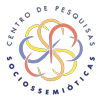Escalas do tempo
DOI:
https://doi.org/10.23925/2763-700X.2021n2.56802Palabras clave:
acidente, acontecimento, coincidência, compromisso, duratividade, intencionalidade, motivação, temporalidadeResumen
Viral epidemics are processes in which temporality obviously constitutes an essential variable. But different time scales must be distinguished. To see the current pandemic as a singular event is but an illusion due to the “mesoscopic” timescale we are embracing. There is a microscopic scale — that of physiological processes —, a mesoscopic scale, which only allows to see the closest evidence, and a macroscopic scale, that of the ecological determinisms which explain the emergence of the disease in the history of the relationships between species. The article focuses on the mesoscopic level and highlights some semiotic specificities of today’s experience : a temporal suspension, the threat of pure, dramatic and final discontinuity, the behavior of a virus that appears to have “intentionality”, a strong intensity coupled with a long duration, a time of exception, drawn to a final end, and a victory which will only be achieved with great effort.
Citas
Alves, Rafael, “Igrejas fechadas : rezar na pandemia”, Acta Semiotica, I, 1, 2021.
Batochio, José Roberto, “Não é genocídio, mas crime contra a humanidade”, O Estado de São Paulo, 30 mai 2021.
Calame, Claude, “L’homme en société et ses relations techniques avec l’environnement : ni nature, ni Gaïa”, Les Possibles, 26, 2020.
Detienne, Marcel et Jean-Pierre Vernant, Les ruses de l’intelligence. La mètis des Grecs, Paris, Flammarion, 1974.
Floch, Jean-Marie, “La maison d’Epicure”, Identités visuelles, Paris, P.U.F., 1995.
Fontanille, Jacques, “La mauvaise foi : une dénégation qui fait sens”, Nouveaux Actes Sémiotiques, Prépublications du séminaire, 2011.
Galofaro, Francesco, “Apocalyptic features of political discourses about the pandemic”, Acta Semiotica, I, 1, 2021.
Greimas, Algirdas J. “O belo gesto”, in V. Abriata e E.M. Nascimento, Formas de vida : Rotina e acontecimento, Ribeirão Preto, Coruja, 2014.
Grignaffini, Giorgio, “Appunti per una sociosemiotica del giardinaggio”, Acta Semiotica, I, 1, 2021.
Landowski, Eric, Interações arriscadas, São Paulo, Estação das Letras e Cores, 2014.
— “Pièges. De la prise de corps à la mise en ligne”, Carte Semiotiche - Annali, 4, 2016.
— “Etat d’urgence”, in V. Estay (éd.), Sens à l’horizon, Limoges, Lambert-Lucas, 2019.
Leone, Massimo, “Critique sémiotique de l’enseignement numérique”, Acta Semiotica, I, 1, 2021.
Peluso, Marina, Il senso della sofferenza. Narratività e forme di vita nelle strategie di gestione del dolore, doutorado em semiótica, universidade de Bolonha, 2012.
Sverdiolas, Ar?nas, “Algirdas J. Greimas’s Egology”, Actes Sémiotiques, 122, 2019.
Uexküll, Jacob von, Milieu animal et milieu humain (1956), Paris, Payot, 2015.
Vasconcelos, Pedro, “Estádios vazios : o torcer em pandemia”, Acta Semiotica, I, 1, 2021.
Zilberberg, Claude, Elementos de semiótica tensiva, São Paulo, Ateliê Editorial, 2011.
Descargas
Publicado
Cómo citar
Número
Sección
Licencia

Esta obra está bajo una licencia internacional Creative Commons Atribución-NoComercial-SinDerivadas 4.0.




